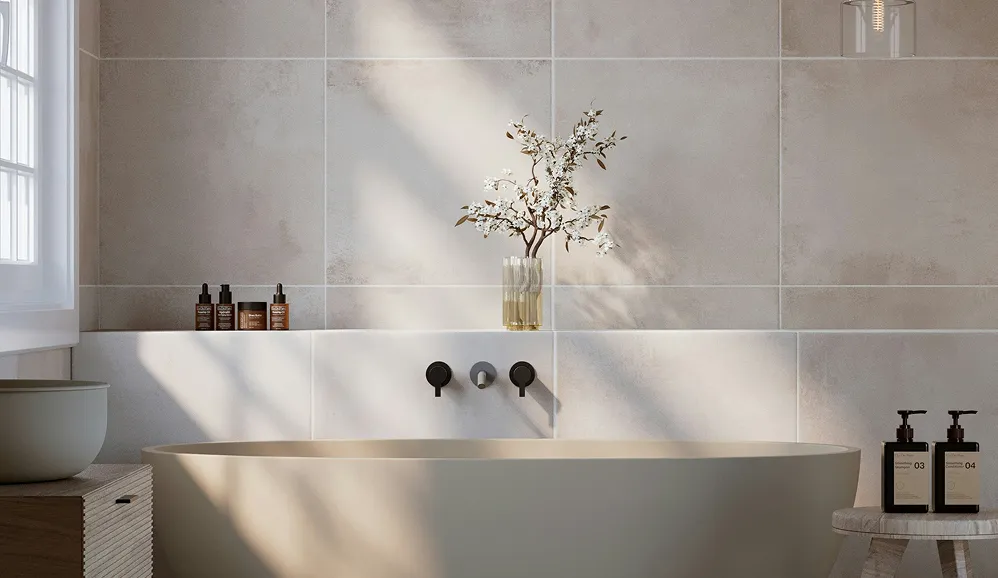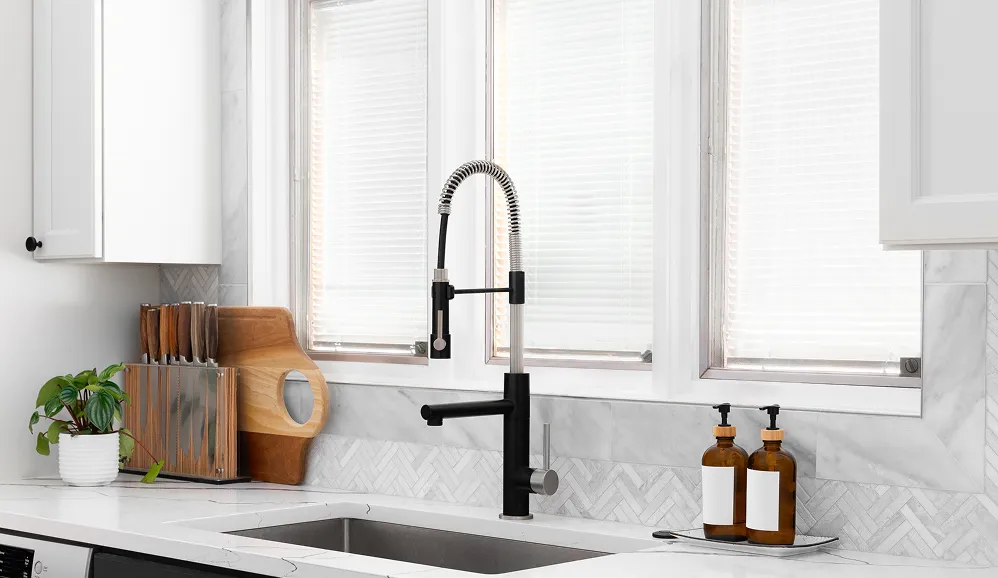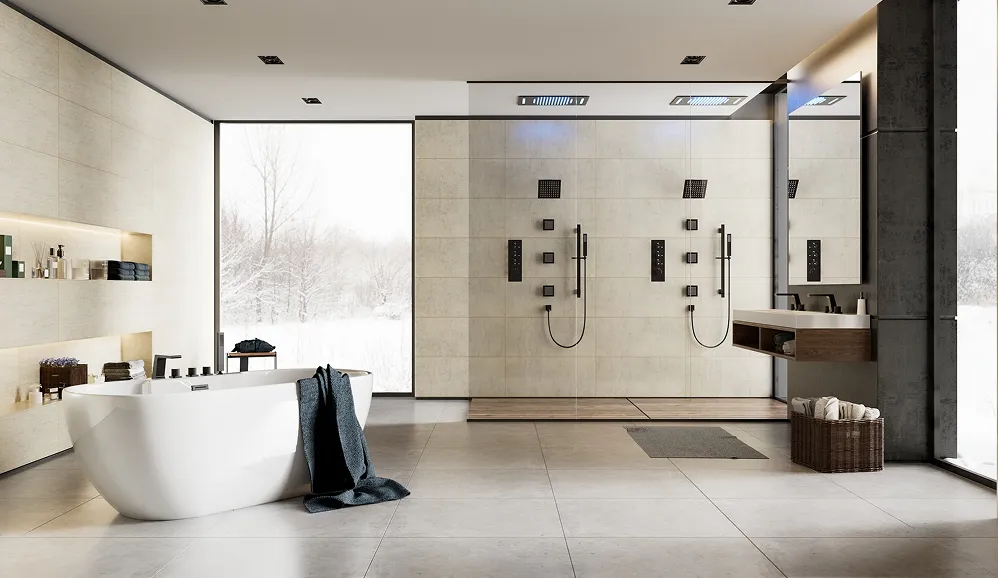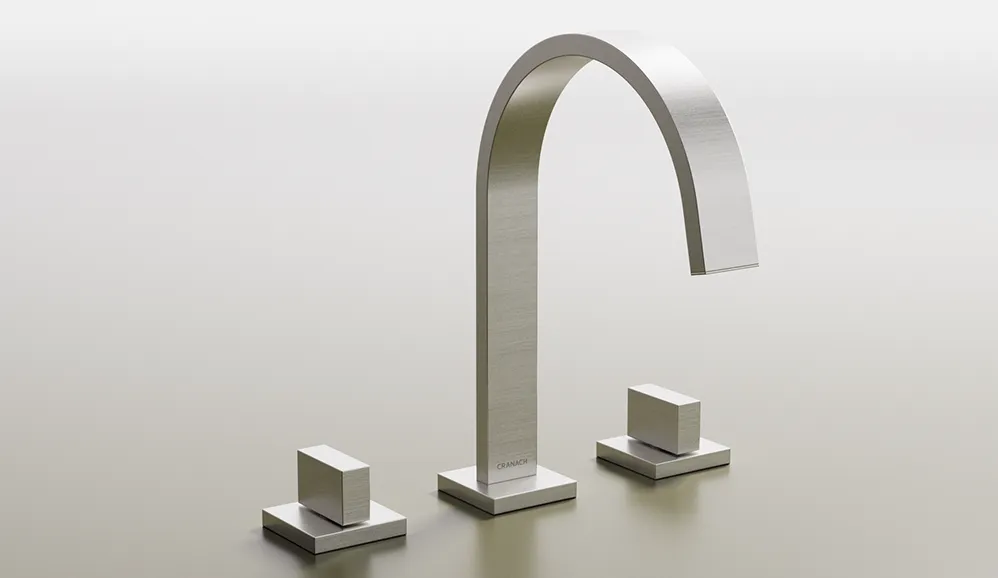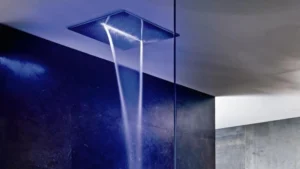Is Your Kitchen Faucet Acting Up?
A dripping faucet, low water pressure, or a wobbly handle can disrupt any kitchen. This guide addresses seven common kitchen faucet problems, offering solutions for homeowners, contractors, plumbers, and anyone tackling remodeling projects. Learn to diagnose and fix issues like leaks, noisy operation, broken sprayers, handle problems, mounting instability, and finish deterioration. Understanding these common kitchen faucet problems will help you save money with DIY repairs and ensure a functional, efficient kitchen.
1. Leaking Faucet
One of the most common kitchen faucet problems homeowners and professionals encounter is a leaking faucet. This issue is characterized by a persistent or intermittent dripping of water from various parts of the faucet, even when the handle is in the fully closed position. These leaks typically originate from the spout, the base, or around the handles. The underlying cause is often the deterioration of essential components within the faucet, such as O-rings, cartridges, seals, or washers. These parts wear down over time due to regular use, and the process can be accelerated by mineral buildup, particularly in areas with hard water. This makes a leaking faucet a prominent entry on any list of kitchen faucet problems.

A dripping faucet isn't just annoying; it's a significant source of water waste. A seemingly minor drip can waste thousands of gallons of water annually, leading to a noticeable increase in water bills. Furthermore, prolonged exposure to even small leaks can cause staining of the sink basin, corrosion of the faucet itself, and even water damage beneath the sink if left unaddressed. For example, a dripping Delta kitchen faucet could waste as much as 3,000 gallons of water a year. In older cartridge-style faucets, calcium deposits from hard water often contribute to leaks around the handle area.
Fortunately, leaking faucets are usually repairable without needing a complete faucet replacement. Early detection and prompt repair can prevent extensive water damage, conserve water, and save money. Many leaking faucet repairs are relatively simple DIY projects if you have the right tools and parts. You can Learn more about Leaking Faucet for more detailed information.
Features of a Leaking Faucet Problem:
- Location: Can manifest at the spout, handle base, or the base of the faucet.
- Progression: Often starts as a slow drip and worsens over time if not addressed.
- Sound: Frequently accompanied by an audible dripping sound, which can be quite disruptive.
Pros of Addressing a Leaking Faucet:
- Repairable: Usually fixable without the expense of a full faucet replacement.
- Prevents Damage: Early intervention avoids water damage and wasted resources.
- DIY Potential: Often an easy DIY repair with readily available parts.
Cons of Ignoring a Leaking Faucet:
- Water Waste: Can waste thousands of gallons of water annually.
- Increased Bills: Contributes significantly to higher water bills.
- Corrosion/Staining: Leads to unsightly staining and corrosion of the faucet and sink.
Actionable Tips for Repairing a Leaking Faucet:
- Turn off the Water Supply: Before starting any repair, locate the shut-off valves under the sink and turn off both the hot and cold water supply lines to the faucet.
- Identify Faucet Type: Determine your faucet type (ball, cartridge, ceramic disc, or compression) as this will dictate the replacement parts you need.
- Clean Parts: Use vinegar to dissolve mineral deposits from the faucet parts before replacing them. This helps ensure a proper seal.
- Use Plumber's Tape: Apply plumber's tape (PTFE tape) to all threaded connections to create a watertight seal and prevent future leaks.
Leading manufacturers like Delta, with their Diamond Seal Technology, and Moen, known for their LifeShine finishes that resist corrosion from leaks, have made strides in preventing faucet leaks. However, even the best faucets can develop leaks over time. Understanding the causes, implications, and solutions for a leaking faucet empowers both homeowners and professionals to address this common kitchen faucet problem effectively.
2. Low Water Pressure
Low water pressure in your kitchen faucet can be a major inconvenience, turning simple tasks like washing dishes or filling a pot into a frustrating ordeal. Instead of a robust stream, you're left with a weak trickle that barely gets the job done. This common kitchen faucet problem results in an insufficient water flow, impacting your daily kitchen routines. This issue can stem from several sources, including clogged aerators, mineral buildup within the pipes, partially closed shut-off valves under the sink, leaking pipes elsewhere in your plumbing system, or even problems with the municipal water supply. Pressure issues can affect both hot and cold water lines or just one, further complicating the diagnosis.

Low water pressure deserves a prominent place on any list of kitchen faucet problems due to its prevalence and impact on usability. The reduced water flow compared to normal operation is a clear indicator of this issue. Often, the problem develops gradually, making it easy to overlook until the flow is significantly diminished. Learn more about Low Water Pressure to understand the nuances of this common plumbing concern. Low water pressure can be a frustrating issue in the kitchen. Before attempting DIY fixes, it's helpful to understanding the root cause of low water pressure and determine if the problem is isolated to your kitchen or affects your entire home.
Features of Low Water Pressure:
- Reduced water flow compared to normal faucet operation.
- May affect hot water, cold water, or both lines.
- Often a gradual deterioration of pressure over time.
Pros of Addressing Low Water Pressure:
- Often fixable without the need for a professional plumber, saving you money.
- Can be an early indicator of more serious plumbing issues, allowing for preventative maintenance.
- Addressing the issue can improve the longevity of your kitchen fixtures.
Cons of Low Water Pressure:
- Makes everyday kitchen tasks more time-consuming and inconvenient.
- Can sometimes indicate more serious underlying plumbing problems that require professional intervention.
- May require multiple attempts at different fixes to resolve completely.
Examples of Low Water Pressure Issues:
- Calcium buildup in a Kohler faucet aerator, reducing the effectiveness of the spray pattern and overall flow.
- A noticeable drop in water pressure after installing a water filtration system without properly sizing it for your plumbing.
Tips for Troubleshooting and Fixing Low Water Pressure:
- Check and clean the aerator: Unscrew the aerator from the faucet tip and soak it in a vinegar solution to dissolve mineral deposits. This is often the simplest and most effective solution.
- Ensure shut-off valves are fully open: Check the hot and cold water shut-off valves located under your sink. Make sure they are both turned fully on.
- Test pressure at multiple fixtures: Run the water in other sinks and showers to determine if the low pressure is isolated to your kitchen faucet or a house-wide problem. This helps pinpoint the source of the issue.
- Install a water pressure gauge: A pressure gauge can accurately measure the water pressure at your faucet, providing valuable information for diagnosis and repair.
- Check for kinked supply lines: Inspect the flexible supply lines connected to your faucet under the sink. Kinks can restrict water flow.
Popularized By:
- Kohler: Known for high-pressure faucets designed to overcome inherent pressure limitations in some homes.
- Moen: Offers faucets with "Power Boost" technology specifically designed to increase water flow rate and pressure.
3. Noisy Faucet Operation
A noisy kitchen faucet can be more than just an annoyance; it's often a key indicator of underlying plumbing issues. From a gentle whistle to a jarring bang, these sounds signify problems that, if left unaddressed, can escalate into costly repairs and even water damage. This makes noisy faucet operation a critical kitchen faucet problem that homeowners, contractors, and plumbers alike should understand and address promptly.
Noisy faucet operation encompasses a range of unusual sounds emanating from your kitchen faucet during use. These sounds can manifest as squealing, whistling, banging (often referred to as water hammer), or chattering. They can occur when turning the faucet on or off, or even during normal operation. The intensity of these noises can also fluctuate depending on water pressure and temperature.
Understanding the Causes:
These auditory clues often point to internal issues within the faucet or plumbing system. Common culprits include:
- Loose Parts: Over time, components within the faucet can loosen, causing vibrations and rattling sounds.
- High Water Pressure: Excessive water pressure can stress the faucet's internal mechanisms, leading to whistling or squealing.
- Worn Components: Worn-out O-rings, washers, or valve seats can create whistling sounds due to turbulent water flow.
- Air in the Lines: Trapped air in the water lines can cause sputtering and chattering noises.
Examples of Noisy Faucet Problems:
- Water Hammer: This loud banging sound, commonly experienced with pull-down faucets like some Pfister models, occurs when the water flow is abruptly stopped, causing a pressure wave to reverberate through the pipes.
- Whistling: Worn valve seats in faucets, such as some American Standard models, can restrict water flow and create a high-pitched whistling sound.
Why Addressing Noisy Faucets is Important:
Ignoring a noisy faucet is like ignoring a check engine light in your car – it's a warning sign that shouldn't be disregarded. While the initial noise might be minor, the underlying problem can worsen over time, leading to:
- Leaks: Worn components or high water pressure can eventually lead to leaks, wasting water and potentially causing damage.
- Component Failure: Continued stress on the faucet's internal parts can lead to premature failure, requiring costly repairs or replacement.
Pros of Early Detection:
- Early Warning Sign: Noisy operation serves as an early warning, allowing you to address the issue before it escalates.
- Simple Maintenance Fixes: Many noise issues can be resolved with simple DIY maintenance tasks.
- Preventative Measure: Addressing the noise can prevent more serious and expensive damage.
Cons and Challenges:
- Difficult Diagnosis: Pinpointing the exact cause of the noise can sometimes be challenging.
- Potential for Larger Issues: The noise may indicate more complex plumbing issues beyond the faucet itself.
- Specialized Tools/Knowledge: Some solutions might require specialized tools or plumbing knowledge.
Actionable Tips for Troubleshooting Noisy Faucets:
- Whistling/Squealing: Try cleaning or replacing the cartridge or valve assembly. This often involves turning off the water supply, disassembling the faucet handle, and accessing the internal components.
- Water Hammer (Banging): Install water hammer arrestors. These devices absorb the pressure wave and prevent the banging sound.
- Rattling: Tighten all accessible connections under the sink, including the supply lines and the faucet's mounting nuts.
- Chattering: Check the water pressure using a pressure gauge. If it's too high (above 80 psi), consider installing a pressure regulator. Also, wrapping exposed pipes with insulation can help reduce noise transmission.
Industry Leaders in Quiet Faucet Technology:
Companies like Delta, with their quiet-operation Diamond Valve technology, and Grohe, known for their SilkMove ceramic cartridges, have prioritized minimizing faucet noise. These innovations demonstrate the importance of quiet operation in modern faucet design.
By understanding the causes of noisy faucet operation and taking proactive steps to address them, you can prevent minor annoyances from turning into major plumbing headaches. Whether you're a homeowner, contractor, or plumber, recognizing and resolving these issues is essential for maintaining a functional and efficient kitchen.
4. Broken Sprayer or Pull-Down Function
A broken sprayer or pull-down function is a common kitchen faucet problem, especially with modern faucet designs. This feature, popularized by brands like Moen (with their Reflex pull-down system and Power Clean spray technology), Kohler (DockNetik), and Delta (MagnaTite), offers enhanced flexibility for rinsing dishes and cleaning the sink. However, this added functionality introduces potential points of failure. This problem deserves its place on this list due to its prevalence in modern kitchens and the disruption it causes to daily kitchen tasks. Understanding the mechanics and common issues can help homeowners and professionals alike troubleshoot and resolve these problems effectively.
These pull-down or pull-out spray heads work by using a weighted hose system that allows the spray head to be extended for use and then retract neatly back into the faucet spout. A diverter valve within the faucet body controls the flow of water between the main faucet and the sprayer head, and often allows for switching between different spray patterns. When functioning correctly, this system provides a convenient and efficient way to direct water flow as needed.
Features and Issues:
A malfunctioning sprayer can manifest in several ways:
- Failure to retract properly: The spray head might dangle loosely, refuse to retract fully, or retract slowly. This is often caused by a kinked hose, an issue with the retraction weight mechanism, or an obstruction under the sink catching the hose. A common example is the Moen Reflex system failing to retract correctly due to hose catching on under-sink items. Learn more about Broken Sprayer or Pull-Down Function
- Inability to switch between spray patterns: If the spray pattern doesn't change or the diverter sticks, the problem usually lies with a clogged or faulty diverter valve within the faucet body.
- Leaking from the spray head or hose: Leaks commonly occur at the connection point between the hose and the spray head or at the base of the faucet. Delta pull-down sprayers, for instance, are sometimes known to develop leaks where the hose connects to the spray head.
- Reduced water flow through sprayer: Mineral buildup within the spray head or a partially kinked hose can restrict water flow, resulting in a weak spray.
Pros and Cons of Repairing a Broken Sprayer/Pull-Down Function:
Pros:
- Many issues can be resolved without requiring a complete faucet replacement.
- Manufacturers often supply replacement parts under warranty.
- Diagnosing the specific issue can be straightforward with some basic testing.
Cons:
- Replacement parts can be brand-specific and difficult to locate.
- Accessing the hose often requires removing items stored under the sink.
- Multiple components (e.g., hose, spray head, diverter) might need replacement simultaneously.
Actionable Tips:
- Clear the area under the sink: Remove any items that might obstruct or snag the pull-down hose.
- Adjust the counterweight position on the hose: The counterweight helps with retraction; adjusting its position can improve performance.
- Soak the spray head in a vinegar solution: This helps dissolve mineral deposits clogging the spray holes.
- Check for kinks or twists in the pull-down hose: Straighten any kinks or replace the hose if necessary.
- Ensure the spray diverter is clean and functioning properly: Disassemble and clean the diverter or replace it if it's faulty.
When and Why to Use This Approach:
Addressing a broken sprayer or pull-down function is crucial for restoring the full functionality of your kitchen faucet. This approach is preferable to complete faucet replacement whenever possible, as it is typically less expensive and time-consuming. If you experience any of the symptoms described above, troubleshooting the sprayer system is a worthwhile endeavor. However, if the faucet is very old or the damage is extensive, a full replacement might be the more practical solution. This information is valuable for homeowners, plumbers, contractors, builders, and anyone involved in kitchen remodeling or maintenance, as it empowers them to diagnose and address common kitchen faucet problems.
5. Handle and Control Issues
Handle and control issues are a common category of kitchen faucet problems, impacting the faucet's usability and your ability to control water flow and temperature. This encompasses anything from a slightly stiff handle to a complete inability to turn the faucet on or off. Addressing these problems promptly is important, not only for convenience but also to prevent further internal damage and potentially costly repairs down the line. This is why understanding handle and control issues deserves a prominent place on our list of common kitchen faucet problems.
These issues manifest in several ways, affecting how the faucet operates:
- Stiff or difficult handle movement: This can make it challenging to turn the faucet on or off and to fine-tune the water temperature.
- Loose or wobbly handle operation: A loose handle can feel unstable and may not effectively control the water flow. It can also be a sign of a more serious underlying problem.
- Inconsistent temperature control: Fluctuations in water temperature, even when the handle position is held constant, indicate a problem with the internal control mechanism.
- Handle that comes off or doesn't properly attach: This signifies a significant problem with the handle's connection to the faucet body, often due to a broken or loose part.
Several factors can contribute to these issues, including:
- Cartridge problems: The cartridge is the internal valve that controls water flow and temperature. Wear and tear, mineral buildup, or damage can affect its operation.
- Mounting hardware deterioration: Loose screws or corroded mounting hardware can lead to a wobbly or detached handle.
- Mineral buildup: Hard water can deposit minerals on internal parts, hindering their movement and causing stiffness.
- Normal wear and tear: Over time, moving parts can wear out, leading to operational problems.
Pros of Addressing Handle and Control Issues:
- Often repairable: Many handle and control issues can be resolved by tightening screws, cleaning parts, or replacing specific components like the cartridge. Learn more about Handle and Control Issues
- Prevents further damage: Addressing minor issues early can prevent more significant and costly damage to the internal workings of the faucet.
- Upgrade opportunity: Repairing a handle issue can be a good opportunity to upgrade to a newer, more efficient, or feature-rich control mechanism. For example, you might consider replacing a standard cartridge with a ceramic disc valve for smoother, more durable operation.
Cons of Addressing Handle and Control Issues:
- Specialized tools: Some repairs may require specialized tools, such as cartridge pullers, which you may need to purchase or borrow.
- Difficult access: Some faucets have difficult-to-access set screws or mounting hardware, making repairs more challenging.
- End of lifespan: In older models, handle and control problems can sometimes indicate that the faucet has reached the end of its lifespan and replacement is the most cost-effective solution.
Examples of Handle and Control Issues:
- Moen single-handle faucets are sometimes known for developing loose operation due to set screw loosening.
- Kohler ceramic disc valve faucets can become stiff due to mineral buildup.
Actionable Tips for Troubleshooting and Repair:
- Locate and tighten set screws: These screws often secure the handle to the faucet body and are commonly hidden under decorative caps.
- Remove the handle: Removing the handle allows access to the cartridge and other internal parts for cleaning and lubrication.
- Clean and lubricate the cartridge: Mineral deposits can be removed with vinegar or a specialized cleaning solution. Apply food-grade silicone lubricant to moving parts for smoother operation.
- Replace parts: When replacing parts, bring the old parts to the store to ensure an exact match. Companies like Grohe, with their SilkMove ceramic cartridge technology, Hansgrohe, with their QuickClean anti-limestone system, and Brizo, with their SmartTouch technology, have popularized innovative solutions for smoother operation and reduced maintenance.
- Take photos: Photograph each step of the disassembly process to aid in reassembly.
By understanding the potential causes of handle and control issues and following these tips, homeowners, contractors, plumbers, and anyone involved in home renovation and maintenance can effectively address these common kitchen faucet problems and ensure smooth and reliable operation.
6. Base and Mounting Stability Issues
Base and mounting stability issues are a common source of kitchen faucet problems. This refers to how securely the faucet attaches to the sink or countertop. A stable base is crucial for a well-functioning faucet. Problems in this area can manifest as a loose or wobbly faucet, leaks around the base due to improper sealing, insufficient support – particularly on thin stainless steel sinks – or difficulties with the mounting hardware itself. These stability issues not only make using the faucet frustrating but can also lead to significant water damage beneath the sink, affecting cabinets and countertops if water seeps through compromised connections. Addressing these issues is vital for both functionality and preventing costly repairs.

Several telltale signs indicate base and mounting instability. These include: a faucet that moves or rocks when you operate the handle; water pooling around the base of the faucet, hinting at a leak; visible gaps between the faucet base and the mounting surface; and mounting nuts that refuse to tighten properly. For example, some Kraus faucets have been known to require additional stabilization when installed on thin stainless steel sinks, while certain American Standard models may develop leaks around the base due to deteriorated gaskets over time. These issues highlight the importance of proper installation and maintenance to prevent future kitchen faucet problems.
This type of kitchen faucet problem deserves a place on this list because it's a frequent issue and, if left unaddressed, can lead to substantial damage. While it might seem minor, a wobbly faucet is more than just an annoyance. It's a symptom of a larger problem that can cause water damage and shorten the lifespan of your faucet.
Pros of Addressing Base and Mounting Issues:
- Fixable without full replacement: In most cases, you can resolve these issues without needing to replace the entire faucet, saving you money.
- Improved lifespan: A securely mounted faucet will last longer and operate more smoothly.
- Prevents water damage: Addressing leaks and instability protects your cabinets and countertops from water damage.
Cons of Addressing Base and Mounting Issues:
- Awkward access: Reaching the under-sink mounting hardware can be challenging and require contorting yourself into uncomfortable positions.
- Specialized tools: You might need tools like a basin wrench for effective tightening in tight spaces.
- Two-person job: Some fixes, especially aligning the faucet during installation, are easier with an extra set of hands.
Actionable Tips for Fixing Base and Mounting Issues:
- Use a basin wrench: This specialized tool provides the leverage needed to tighten mounting nuts effectively in confined spaces.
- Seal with plumber's putty or silicone: Applying plumber's putty or silicone caulk under the base plate creates a watertight seal and prevents leaks.
- Reinforce thin sinks: Install a backing plate or mounting bracket under the sink to provide additional support for the faucet, especially with thin stainless steel sinks.
- Clean mounting surface: Ensure the mounting surface is clean and free of debris before installation for a proper seal.
- Check supply lines: Make sure the supply lines aren’t pulling or putting tension on the faucet, which can cause it to loosen over time.
Companies like Moen, Kohler, and Danze have recognized the importance of a stable base and have implemented features to address these potential kitchen faucet problems. Moen's Spot Resist finish, for instance, minimizes the visibility of water spots around the base, making minor leaks less noticeable. Kohler offers easy-install mounting systems designed for a more secure and straightforward installation process. Danze utilizes sturdy brass mounting hardware for added durability and stability. By understanding the common causes of base and mounting stability issues, and taking proactive steps to address them, you can ensure a longer-lasting, more functional, and problem-free kitchen faucet.
7. Finish Deterioration and Cosmetic Damage
Finish deterioration and cosmetic damage are common kitchen faucet problems that affect the faucet's appearance. This degradation includes issues like tarnishing, discoloration, peeling, scratching, and corrosion of the finish. While these problems may start as purely aesthetic concerns, they can eventually impact the faucet's functionality if corrosion progresses and reaches internal components. This makes finish deterioration a significant kitchen faucet problem deserving of attention.
Different faucet finishes have varying levels of resistance to damage. For example, chrome, stainless steel, bronze, matte black, and nickel each react differently to certain cleaning agents and environmental factors. Understanding your faucet's finish is crucial for proper care and maintenance.
Features of Finish Deterioration:
- Visible scratching, peeling, or flaking of the finish: This is often caused by abrasive cleaning tools or accidental contact with hard objects.
- Discoloration or spotting (especially on metallic finishes): Hard water, acidic cleaners, or even certain foods can cause unsightly spots and discoloration.
- Corrosion or rust development: This is a more serious issue, indicating that the protective finish has been compromised, exposing the underlying metal to moisture and air.
- Uneven appearance or dull patches: This can result from inconsistent cleaning practices or the use of inappropriate cleaning products.
Pros of Addressing Finish Issues Early:
- Some finish issues, like minor spotting, can be addressed with specialized cleaning products designed for your specific finish.
- Early intervention can prevent deeper corrosion and potentially prolong the life of your faucet.
- Some manufacturers offer finish warranty protection, allowing for replacement parts or even a new faucet if the finish deteriorates prematurely.
Cons of Finish Damage:
- Severe finish damage is often impossible to completely restore without replacing the affected parts or the entire faucet.
- It can be difficult to match replacement parts to aged finishes, especially if the faucet is discontinued.
- Some cleaners intended to help remove spots or stains may actually worsen the damage if they are too harsh for the particular finish.
Examples of Finish Deterioration:
- A Delta faucet with a Venetian Bronze finish showing spotting from acidic cleaners.
- A Moen faucet with spot-resistant stainless steel developing dull patches from abrasive cleaning pads.
Actionable Tips to Prevent and Address Finish Deterioration:
- Use only manufacturer-recommended cleaning products: Learn more about Finish Deterioration and Cosmetic Damage for specific recommendations. This is the single most important step in preserving your faucet's finish.
- Avoid abrasive cleaners and tools: Especially on special finishes like matte black or oil-rubbed bronze, abrasive cleaners and scouring pads can easily scratch and dull the surface. Opt for soft cloths and gentle cleaning solutions.
- Dry your faucet after each use: This simple step can prevent water spots and mineral buildup, which can lead to discoloration and corrosion over time.
- Apply automotive wax to some finishes (check manufacturer recommendations): A thin layer of automotive wax can provide an extra layer of protection against water spots and minor scratches on certain finishes.
- Consider a water softener: If you live in an area with hard water, a water softener can significantly reduce mineral buildup on your faucet, preventing spotting and discoloration.
Popularized Finishes Resistant to Deterioration:
Manufacturers like Kohler, Delta, and Moen have developed innovative finishes designed to resist tarnishing and corrosion. Kohler's vibrant PVD finishes, Delta's Brilliance finish, and Moen's Spot Resist stainless finish technology are all examples of durable finishes that can withstand daily wear and tear.
For homeowners, contractors, builders, plumbers, and anyone involved in interior design or remodeling, understanding the causes and prevention of finish deterioration is essential for maintaining the beauty and longevity of kitchen faucets. Addressing these kitchen faucet problems promptly will save you money and frustration in the long run.
7 Kitchen Faucet Problems Comparison
| Problem | 🔄 Implementation Complexity | ⚡ Resource Requirements | ⭐ Expected Outcomes | 💡 Key Advantages |
|---|---|---|---|---|
| Leaking Faucet | Low-Medium – Typically DIY with replacement parts needed | Minimal tools; common O-rings, seals | Prevents water waste and damage if fixed early | Repairable without complete replacement; cost-effective |
| Low Water Pressure | Low – Mainly involves cleaning and valve adjustments | Basic tools; vinegar solution, pressure gauge | Restores effective water flow and fixture efficiency | Early troubleshooting may uncover broader plumbing issues |
| Noisy Faucet Operation | Medium – Diagnosis and component adjustments required | May need specialized tools like water hammer arrestors | Achieves quieter operation and signals early maintenance needs | Simple fixes can prevent more serious damage |
| Broken Sprayer or Pull-Down Function | Medium-High – Involves component replacement and precise adjustments | Brand-specific parts; standard reassembly tools | Restores full spray functionality and multi-mode use | Often covered under warranty; straightforward troubleshooting |
| Handle and Control Issues | Medium – Involves disassembly, lubrication, and occasional tightening | Specialized tools; lubricants and exact replacement parts | Ensures smooth control and consistent temperature adjustment | Targeted repairs can extend faucet lifespan |
| Base and Mounting Stability Issues | Medium-High – Challenging due to under-sink access and mounting adjustments | Basin wrench, sealing compounds, and proper mounting hardware | Enhances stability and prevents water damage | Correct mounting prevents long-term structural issues |
| Finish Deterioration and Cosmetic Damage | Low – Maintenance-oriented cleaning and careful handling required | Specialized cleaning products and wax; non-abrasive materials | Restores visual appeal while preventing further corrosion | Routine care maintains finish and extends aesthetic life |
Keeping Your Faucet Flowing Smoothly
From leaks and low water pressure to handle issues and sprayer malfunctions, this article has covered the gamut of common kitchen faucet problems. We've explored the causes behind these issues, offered troubleshooting tips, and highlighted the importance of prompt repairs. Mastering these simple diagnostic and maintenance techniques empowers you to address many kitchen faucet problems yourself, saving you time and money. Remember, the key takeaways are to always turn off the water supply before any repair attempt and to perform regular maintenance to avoid more serious issues down the line. By understanding and addressing these common kitchen faucet problems, you not only ensure a smoothly operating kitchen but also contribute to water conservation and the longevity of your fixtures.
A well-functioning faucet is essential for a productive and enjoyable kitchen experience. Don't let kitchen faucet problems disrupt your flow! If you're looking to upgrade to a reliable and stylish faucet or are simply exploring your options, visit Cranach bath and kitchen. Cranach offers a wide range of high-quality kitchen faucets designed to resist many of the common issues discussed here, ensuring lasting performance and a touch of elegance for your kitchen.

